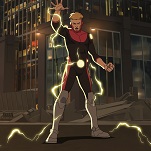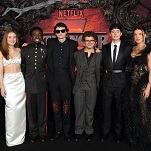Readers debate the benefits of games’ first-person perspective

A View To Something Other Than A Kill
This week, we published the second of two articles from the duo behind Chicago’s Video Game Art Gallery. This time around, Chaz Evans, the gallery’s director of exhibitions, covered the history of games that make use of first-person perspectives for anything but combat. In the comments, the conversation turned to the strengths and weaknesses of this more intimate view. Merve kicked things off:
I quite like first-person shooters, but I agree with Mr. Evans that the first-person perspective has so much potential to be used for purposes other than shooting. It lends itself well to exploration. When you walk through a digital environment, you see it as a person in that world would. It’s perfect for games that cast you in the role of an archaeologist uncovering the secrets of an arcane world, like Kairo or Fract OSC. It’s also excellent for focusing your eyes on particular clues and making specific observations, which is exactly what a researcher would do.
The third-person perspective lends itself well to exploration of a different kind. Third-person exploration is all about the journey. It emphasizes scale and scope. By pulling the camera back from the player, it gives you a wider view of the landscape. Instead of seeing disparate elements of the environment, you see them working together as a whole.
I think that’s part of the reason why so many puzzle games (Portal, Antichamber, Q.U.B.E., The Talos Principle) set themselves in the first person, whereas role-playing games tend to be in the third person. Puzzle games want you to scan the environment for specific components or clues. RPGs want the player to consider the environment as a singular entity.
Duwease and Ghaleon Q followed that train of thought, saying it’s the perspective’s sight limitations that make it effective. Here’s Ghaleon:
First-person is a limiting—rather than revealing—perspective, something shooters take advantage of when involving cover, line of sight, and chaos. Using this limited perspective makes exploration, pondering, and solving in a game like Penumbra much more daunting an experience than in, say, The Legend Of Zelda and, perhaps, maximizes the sense of triumph one feels at the end.
The most underrated use is in role-playing games, though, especially dungeon crawlers. Third-person dungeon crawlers force you to make mathematical calculations based on your grasp of the entire visible dungeon, which is one way to challenge a player: Give you a lot of information and force you to sift through the important things. Playing, say, Beyond The Labyrinth, Phantasy Star, or the Ultima Underworld games does the opposite, giving you little information and hoping you get lost unless you can keep your wits about you to manage resources and escape.
And ItsTheShadsy followed up with some great examples to illuminate the baffling effect this lack of awareness in first-person games can have:
The best point of comparison I can think of is the various attempts at translating Pac-Man into a first-person experience. Pac-Man works largely because we can see the full maze and where every object is. As anyone who’s navigated a maze in person can attest, it’s not so simple. A few years back, I played a virtual reality Pac-Man game, and it was incredibly difficult to keep up with the somewhat fast pace of Pac-Man when you’re trying to figure out the maze at the same time. The developers made a concession and lowered the walls, allowing you to see across the maze at any time, but it was still very, very difficult to have a sense of what was where.







































